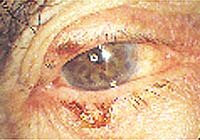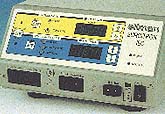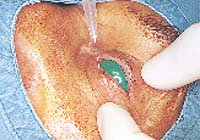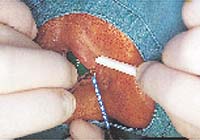Radiosurgery can be useful in the treatment of basal cell carcinoma of the eyelids
In selected cases of basal cell carcinomas, when the tumor is small and its borders are well defined, radiosurgery may be an alternative to traditional surgery.
Basal cell carcinoma is a malignant tumor derived from cells of the basal cell layer of the epidermis. The etiology of basal cell carcinoma is linked to excessive ultraviolet light exposure in fair-skinned individuals. Other predisposing factors include ionizing radiation and scars. While metastases are rare, local invasion is common and can be very destructive.
Basal cell carcinoma is the most common malignant tumor of the eyelids; it comprises 85% to 90% of all malignant epithelial eyelid tumors at this site. Over 99% of basal cell carcinomas occur in Caucasians; about 95% of these lesions occur between the ages of 40 and 80 years, with an average age at diagnosis of 60 years.
Ocular manifestations

 ---Local malignancy of basal cell carcinoma.
---Local malignancy of basal cell carcinoma.
Two-thirds of basal cell carcinomas affect the lower eyelid. The medial canthus and upper eyelid are involved with a nearly equal incidence of about 15%. The lateral canthus is only rarely involved (5%). Based upon their histopathologic presentation, basal cell carcinomas may be classified into five basic types: nodular-ulcerative, pigmented, morphea or sclerosing, superficial and fibroepithelioma.
The diagnosis of basal cell carcinoma is initially made from its clinical appearance, especially with the nodulo-ulcerative type with its raised pearly borders and central ulcerated crater. Definitive diagnosis, however, can only be made on histopathologic examination of biopsy specimens.
Treatment
 ---Ellman IEC device.
---Ellman IEC device.
The goal of therapy is the complete removal of tumor cells with preservation of unaffected eyelid and periorbital tissues. While nonsurgical treatments such as cryotherapy, electrodesiccation and laser ablation are advocated by some, surgical therapy is generally accepted as the treatment of choice for removal of basal cell carcinomas.
In selected cases of basal cell carcinomas (especially in the superficial or pigmented types), when the tumor is small and its borders are well defined, radiosurgery at 4 MHz could be a valid alternative to traditional surgery.
Radiosurgery
Radiosurgery is an atraumatic method of cutting and coagulating soft tissue by means of ultra high frequency radiowaves passing through the tissue cells.
The radiosurgical unit produces radiowaves at 4 MHz, which are transmitted to a metallic wire electrode and a passive metallic ground plate. The unit that we used in this study, and that delivers the patented frequency and selection of waveforms, is the Ellman (Hewlett, N.Y.) IEC device.
The soft tissue is placed between the two electrodes and the radio signal is directed from the active to the passive electrode. The passage of ultra high frequency radiowaves causes the cells to heat up as a result of the tissue’s natural resistance to the radiosignal. The cutting effect is achieved as a result of cell modulation or volatilization, which results from the heat generated by the tissue’s natural resistance to the passage of the active electrode. The radio signal is directed through the tissues by the active microwire electrode. The radiowaves generated by the radiosurgical unit may be modified in their waveform and power, and the frequency remains constant.
Using a fully rectified and filtered waveform, a biopsy may be easily accomplished without any necrosis of the cells along the incision. For large lesions, it is extremely important that the biopsy includes adjacent normal tissue.
Study
In our study, 10 selected cases of basal cell carcinoma of eyelids (nodular and/or superficial basal cell carcinomas) have been treated with radiofrequency with local anesthesia. Six cases were located on the lower eyelid, two cases on the upper eyelid and two cases on the medial canthus. When a lesion develops clinical features that suggest malignant degeneration, such as a rapid and irregular growth, bleeding and ulceration, radiosurgery was not employed. It is, therefore, mandatory to always perform a histologic examination of the biopsied tissue.
All patients have been treated by the same surgeon. The biopsy confirmed the diagnosis of basal cell carcinoma. After treatment (3 years follow-up), the cosmetic result was very good and no complications were noted.
Conclusions
Radiosurgery at 4 MHz may be very useful in the treatment of well-delimited basal cell carcinoma of the eyelids. This kind of seemingly easy excisional procedure may be complicated by anatomical and histological differences of each tumor. However, if it is correctly performed, it gives satisfactory results. It is mandatory to perform a histologic examination of all biopsied tissue.
Complete surgical excision of basal cell carcinoma almost always is curative, since these lesions rarely metastasize. The incidence of metastasis ranges from 0.028% to 0.55%. Tumor-related death is exceedingly rare; but when it does occur, it usually is caused by direct orbital and intracranial extension.




Patient with pigmented lesion of the inferior eyelid before, during and after radiosurgery.
For Your Information:
- Herve M. Byron, MD, can be reached at 114 Roberts Road, Englewood Cliffs, NJ 07632; (201) 567-9479; fax: (201) 568-7765; e-mail: byronmd@rcn.com. Dr. Byron has no direct financial interest in any of the products mentioned in this article. He is a paid consultant for Ellman International.
Reference:
- Ellman International can be reached at 1135 Railroad Ave., Hewlett, NY 11557-2316; (516) 569-1482; fax: (516) 569-0054; e-mail: ellman@ellman.com.
- Lee SB, Saw SM, Eong KG, Chan TK, Lee HP. Incidence of eyelid cancers in Singapore from 1968 to 1995. Br J Ophthalmol. 1999;8:595-597.
- Lindgren G, Diffey BL, Larko O. Basal cell carcinoma of the eyelids and solar ultraviolet radiation exposure. Br J Ophthalmol. 1998;82:1412-1415.
- Pieh S, Kuchar A, Novak P, Kunstfeld R, Nagel G, Steinkogler FJ. Long-term results after surgical basal cell carcinoma excision in the eyelid region. Br J Ophthalmol. 1999;83:85-88.
